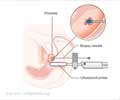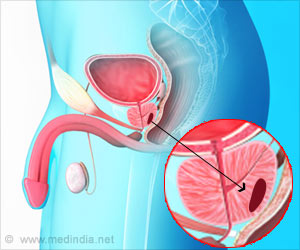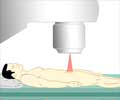A single escalated dose of brachytherapy radiation is found to be effective for the treatment of localized prostate cancer, reveals study.

- Prostate cancer is the most common cancer among men.
- Brachytherapy involves the use of radiation source to destroy the prostate cancer cells.
- New study finds single escalated dose of brachytherapy implants to be safe and effective for localized prostate cancer when compared to low dose therapy.
According to the American Cancer Society, around 161,360 cases of prostate cancer will be diagnosed in the United States in 2017.
Brachytherapy or the internal radiation therapy (RT), involves surgical insertion of the implants in or near the cancerous tissue to deliver radiation dose without affecting the healthy tissue.
This treatment reduces the exposure for treating prostate tumors surrounded by multiple critical structures, when compared to low-dose-rate (LDR) brachytherapy.
Low-dose brachytherapy implants are placed permanently inside the body and small doses of radiation are being delivered for over a period of months. While, the newly discovered high-dose rate brachytherapy implant is capable of delivering the dose in one treatment, after which the implant can be removed from the body.
The number of sessions can, however, be reduced, by increasing the dose, the data collected on the safety and tolerability of highly escalated brachytherapy are relatively new and limited.
Daniel J.Krauss, MD, radiation oncologist, Oakland University’s William Beaumont School of Medicine in Royal Oak, Michigan, said, "It is becoming apparent that patients may be treated definitively for their prostate cancer in as little as a single day with a minimally invasive outpatient procedure." "We found that patients generally can resume normal activities the following day with typical side effects.”
Research Study
A non-randomized and a prospective clinical trial of 58 patients between the age of 43 and 73, who had low or intermediate risk for prostate cancer was conducted with a median follow-up of 2.9 years.
The patients were given a 19Gy fraction of HDR brachytherapy and around 91% of the patients were presented with stage T1 disease.
After three years of treatment, the cancer control rates were favorable and the toxicity was also reduced. Three patients were found to experience recurrence or progression, with an estimated control rate of 93%
Seven patients were found to experience grade 2 urinary side effects which commonly includes frequency or urgency, these effects were found within six months after treatment with HDR brachytherapy.
The patients did not experience any grade 3+ urinary toxicity or grade 2 chronic gastrointestinal toxicity. Six of them received grade 2 urinary toxicity, Although, one patient had grade 3 chronic GI toxicity, it was found to resolve. None of the patients were found to experience long-term side effects.
Dr. Krauss, said, "This study illustrates that a potentially curative dose of radiation may be delivered safely to the prostate entirely in a single administration."
"Giving the entire dose in a single treatment theoretically could have had a greater negative impact on the normal tissues in close proximity to the prostate--meaning the bladder, urethra and rectum--but this was not found to be the case. Toxicity rates were extremely low, with essentially no major complications encountered in this initial group of 58 patients."
The study not only highlights the use of a single fraction of HDR brachytherapy for prostate cancer, but also specifies additional follow-up to compare long-term cancer control rates.
Dr. Krauss, said,"As the follow-up interval lengthens, 19 Gy dosing in a single fraction may or may not be sufficient to result in cure rates comparable to historical standards. One thing that this study has made clear, however, is that the extremely low toxicity and complication rates leave room to escalate the single fraction dose in subsequent trials."
"While additional study and longer follow-up are necessary to confirm the optimal dose for single-fraction HDR brachytherapy, we are optimistic that the single-treatment approach can eventually become a standard practice for prostate cancer treatment."
About Brachytherapy
It involves the use of radioactive material to damage the cancer cells. It is one type of radiation therapy which uses a high dose of radiation for treating a small area. Brachytherapy is referred to as Internal beam radiation therapy.
The radioactive implant is operated by a radiation oncologist, medical physicist along with a dosimetrist.
References
- "Daniel J. Krauss et al, Favorable Preliminary Outcomes for Men With Low- and Intermediate-risk Prostate Cancer Treated With 19-Gy Single-fraction High-dose-rate Brachytherapy, International Journal of Radiation Oncology*Biology*Physics (2017). DOI: 10.1016/j.ijrobp.2016.08.011
- About Prostate Cancer - (https://www.cancer.org/content/dam/CRC/PDF/Public/8793.00.pdf)
- Prostate Cancer—Patient Version - (https://www.cancer.gov/types/prostate)
- Brachytherapy - ( https://www.radiologyinfo.org/en/info.cfm?pg=brachy#therapy-operators)
Source-Medindia















